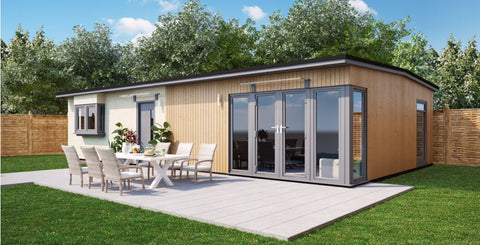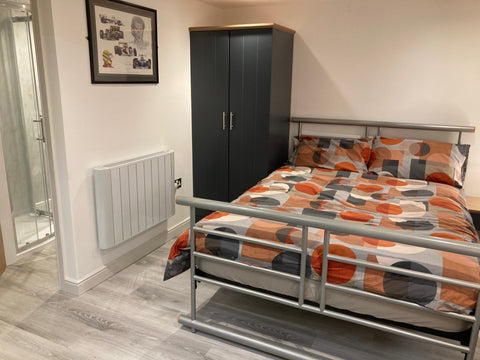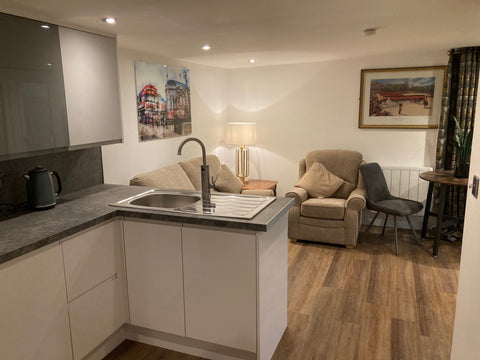With the rising costs of eldercare, residential properties, and even retirement villages - more people than ever are starting to consider viable alternatives to caring for and supporting their elderly loved ones.
If you’ve been searching for a longer-term solution, you might find that granny flats or annexes are great options. But what are they, exactly? And more importantly - what’s the difference between the two?
In this article, we discuss why people are considering alternative options for their elderly loved ones and compare the similarities and differences between granny flats and annexes.
Read on to discover the difference between a granny annexe and a granny flat…
Click here for more information on our Bespoke Styles
Why granny annexes and granny flats have seen an increase in demand
In recent years, we’ve seen a rise in the number of people in the UK looking for ways to be more proactive in caring for their elderly relatives. And, when making a significant financial decision, it’s natural to research all the potential options available.
So, what’s causing the increase in demand for granny annexes or granny flats? Several reasons. The traditional routes, such as long-term nursing homes or retirement villages, are becoming more expensive, causing families to look for more affordable solutions to support their relatives.
JLL, one of the UK’s leading property consultancy services, reported that the average price of purchasing a home within a retirement village had increased by 20%. In addition, rental options also saw a rise of 11%.
On top of these rises, those seriously considering a retirement village can also expect to have to stay on top of the rising costs of outsourcing care professionals and service charges to fund the upkeep of communal spaces.
The above is based on generalised data from the last five years. So, it’s worth keeping in mind that retirement villages can vary depending on many factors (e.g. location, facilities and level of services required), so it’s always best to do independent research.
What about UK nursing homes?
Age UK, a charity dedicated to improving the quality of life for older people, conducted independent research into how much the average person can expect to pay for a nursing home.
The UK charity reported that, generally speaking, for a single person, the cost of a care home can vary anywhere from £600 to £800 a week, with large, metropolitan areas charging a much higher rate than elsewhere. If your loved one requires additional support or services, this would also need to be calculated into the overall cost.
In addition to Age Uk, the UK Care Guide, a resource designed to provide advice to those caring for loved ones in later life, reported that more recent research suggests those in the UK can expect to pay anywhere from £27,000 - £39,000 per year.
If additional support is required (e.g. care provided by qualified nurses), the average rises again to £35,000 - £55,000 a year, depending on where you are in the UK. Some of the population, however, will be eligible for help with funding, subject to means testing.
The rise in costs associated with care is likely down to inflation. We’re also living longer, causing the demand for quality, older life care to increase.
What’s the difference between a granny flat and a granny annexe?
Once you’re aware of the data, it becomes clear why people in the UK are increasingly searching for investment alternatives as a long-term solution.
Plus, there are plenty of non-monetary bonuses to opting for a granny annexe or granny flat, such as being able to spend more quality time with elderly relatives. But what are they, and what’s the difference?
A granny flat and a granny annexe are terms used to describe purpose-built, self-contained accommodation. Both options are usually built with the facilities required for day-to-day living (e.g. a bathroom, kitchenette, bedroom and lounge area).
The main difference between the two is that a granny flat is more commonly associated with being an extension of the main home or a modification of unused space. For example, converting a garage into a granny flat.
A granny annexe is a term used to describe a self-contained living space on the same property grounds. People who choose this option will have a separate building away from the main home, usually located within the available outdoor space. So, although these two properties are close to one another, they are separate places of residence.

Click here for more information on our granny annexe garden rooms
What’s better - a granny flat or a granny annexe?
This will ultimately depend on your personal circumstances and preference. However, many consider granny annexes to be a more appealing option for all parties involved.
With a granny annexe, you’ll reap all of the benefits associated with a granny flat (e.g. increased value to the property and closer proximity to your loved one). But, your elderly relative will also have access to their own space they can call their own, helping to preserve their sense of independence.
This is particularly important, as those facing this transition may feel worried about what will happen and how they may feel.
If you’re struggling to decide which option is best for your family, try comparing the pros and cons. See below for a summary of the main advantages of a granny flat or a granny annexe.

Click here for more information on our Bespoke Styles
Granny flats
As we mentioned earlier, the main advantage of a granny flat is that your elderly relative will now be living with you in the same residence, granting you more quality time with them. Plus, your property will increase in value due to the added living space.
What’s more, if your elderly relative requires a higher level of care, then closer proximity may be the best option for your family.
On the other end of the spectrum, the main disadvantage of choosing a granny flat is the lack of privacy and independence. It is also the more expensive option of the two, and the project can prove quite disruptive to start with, usually taking months to complete.
The price of adding an extension of living space to your home can add up fast once you’ve taken the cost of planning permission fees, complying with building regulations, and labour costs into consideration, not to mention the job itself.
In addition, your immediate family and elderly relative may find it difficult to adjust to cohabitation. The transition to becoming more dependent on you can sometimes be quite tough for the person moving in, as despite the living space being separate, it’s still part of the main home.

Granny annexes
If you and your loved one have agreed that moving into the main residence would be a better and more harmonious alternative for whatever reason, then a granny flat would be what to look for.
However, if you’re searching for a less costly option that’ll provide you with the best of both worlds, but with much less disruption, we recommend investing in a granny annexe.
Similar to a granny flat, a purpose-built granny annexe will also increase the overall value of your property. This is because you’re still adding living space, regardless of whether or not it’s attached to the main home.
Not only that, but the time it takes to complete the build of a granny annexed property, and the overall cost of the project itself, is (generally speaking) considerably less expensive.
Every family is unique, and what’s best for yours may look different to someone else's. For example, it’s very common for elderly loved ones to struggle with becoming more dependent or adjusting to having less privacy. If this is the case, a granny annexe would be a much more suitable option.

Click here for more information on our Annexe Style Garden Rooms
Conclusion
To conclude the article, even though these terms are frequently used interchangeably, a granny flat is more commonly associated with an extension built onto the family home. A granny annexe is a separate outbuilding that sits within the same property lines, utilising the available outdoor space.
Those who opt for a granny flat extension will gain more added living space to the main building, but it can be a much more expensive and messy endeavour due to the nature of the costs associated with this type of construction.
A granny annexe has the potential to be a more cost-effective alternative. Those who choose this option will still see an increase in overall property value, and elderly relatives will have more sense of privacy and independence.
Find out more about granny annexe garden rooms with Rubicon
If you are considering investing in a premium quality granny annexe garden room, get in touch with us today to find out what we can do for you.
At Rubicon, we’re a family-run business with a wealth of experience in bespoke projects. Our friendly team is incredibly passionate about what they do, with every member trained to an extremely high standard. We’ll listen to exactly what you want and take care of everything from start to finish.
Plus, many additional benefits come with choosing us as your garden annexe provider:
- We offer our customers 20-year guarantees (T&Cs apply) for extra peace of mind with their investment.
- We only use quality, long-lasting materials for our projects (such as low-maintenance and hassle-free composite cladding) to ensure a premium finish, every time.
- We can travel far and wide for your project, so don’t be afraid to enquire if you’re miles away!
- We offer an incredibly fast turnaround time, with our annexe projects taking just 4-6 weeks* to complete.
- Customer service has, and always will be, our number one priority.
For a free, friendly consultation, contact Rubicon today, and we’ll be happy to discuss your garden office project
For more garden room information, inspiration and advice, read the Rubicon blog…